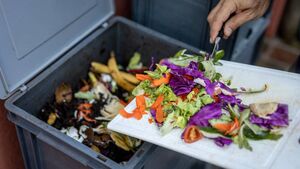Cut down on waste and use those veg cuttings

Look at the food we throw away and realise how much of it is quite edible
One solution to this, of course, is to look at the food we throw away and realise how much of it is quite edible. Bones, skin and fat can be made into broth, leftovers can be disguised in quiches or casseroles, or at least fed to chickens or pigs.
Take, for example, squashes – most people eat only the inner flesh, but roasted pumpkin seeds are a seasonal October treat in America, and other squash seeds taste as good. Melon seeds, too, taste great roasted, and the white melon rind, which we usually throw away, can be pickled and eaten.
Watermelon rinds are widely appreciated in the American South; after you’ve removed all the pink flesh, peel off the outer green skin, take the remaining white rind and soak it in a salt/sugar brine for a few days to remove the bitterness.
Fennel is a plant with a strong liquorice flavour, and people usually eat the bulb, yet few people eat the top – yet the fronds are great chopped up for salad.
The stalks, too, are edible – the only problem is the woody strands in them, but you can either remove those or just add them to a vegetable stock mix and then remove them later.
Corn cobs can also be added to a vegetable stock mix, making a particularly sweet broth that can help offset the bitterness of some other vegetables.
Broccoli and cauliflower stems are brilliant – just peel them of their rind, slice the flesh thinly and make a dressing of mayonnaise, soy sauce, minced garlic and sesame oil.
Beetroots are not just roots – the leaves can be sautéed with onions and garlic, and I put them in omelettes. The stems can also be chopped finely and used, although will take longer to cook. The same is true of chard stems, which are in the same family.
Kale stems can be pickled in brine or simmered and then mashed with garlic and parmesan into a pesto.
Parsley stems can be put into soup stock, but they’re powerful, so don’t overdo it. The same holds for many other herbs.
Many people cut off celery leaves for some reason, even though they’re excellent in salad. The roots, too, are brilliant, and some varieties, like celeriac, are grown just for the roots.
The green parts of leeks should never be thrown away --- they are wonderful in soups and can be sliced thinly and sautéed. You can also stir-fry them.
The yellow skins of onions lend colour to broths, so it’s good to save them and add them when you’re making soup.
The stems of mushrooms can usually be sliced and sautéed, or dried, or pickled.
Potato skins can be baked and served like regular chips but are much more nutritious.
Artichoke leaves can be steamed and then eaten with a mix of butter and lemon juice; once they are cooked through, just take off the leaves one by one, dip them in the butter, chomp down on them with your teeth and pull out the stringy inner leaf, leaving the soft flesh in your mouth.
Pea and bean leaves are usually edible and can be stir-fried.
Best to take a lot of these parts and either dehydrate them or freeze them and keep them for stock. Of course, there are a few major exceptions to this, plants that have some parts that are edible and others that are poisonous.
Nightshades are like this – tomato and potato stems and leaves are famously poisonous, as well as rhubarb leaves. Genuinely inedible parts can be composted or dried and burned and used to feed next year’s crops.





